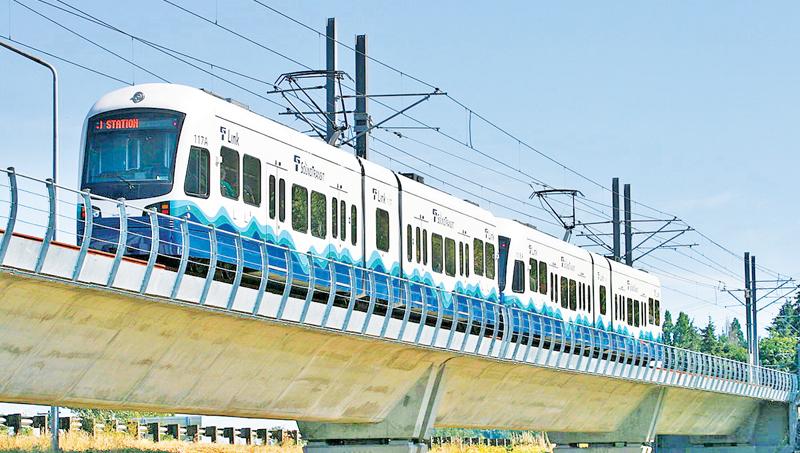
Feasibility studies on the Light Rail Transit (LRT) project which is expected to revolutionise the transportation system in the country has been completed and work on the project will commence by 2020 said a top official of the Urban Development Authority (UDA), the facilitator of the project implemented by the Ministry of Megapolis and Western Development.
He said the project which is estimated to cost US$ 1.7 billion will be funded by Japan International Cooperation Agency (JAICA). The project will be expanded to cover other cities through a private public partnership..
Looking back over the forty-year journey of the UDA which marks this milestone this year, its Director General S.S.P. Rathnayake said the UDA over the years has made a salient contribution to urban planning and development transforming the urban landscape of the country.
“Currently, the UDA is working on the ‘Western Region Administrative Cities Development Project’ to bring all public institutions to one location,” Rathnayake said.
With the Government’s decision to shift the public office buildings in Colombo to the new Capital City, the UDA was entrusted with the construction of two multi-storyed office complexes, the ‘Sethsiripaya’ in Battaramulla and ‘Isurupaya’ at Pelawatta.
A publication by the UDA entitled “ Sri Lanka’s New Capital: Sri Jayawardenepura” identifies all proposed developments to be set up in the new Capital.
In addition to the Parliament building, the new hospital and administrative complexes, a diplomatic enclave, a sports stadium, police headquarters, Open university, cultural centre and a bird park have been identified.
The project will be carried out under three phases which will include the shifting of the President’s and Prime Minister’s official residences to Kotte.
When the Government decided to set up a new administrative capital in Sri Jayawardenepura and build the Parliament in the new capital city the task of implementing the decision was entrusted to the UDA.
The UDA has made investments on iconic buildings such as the Colombo Arcade, the Dutch Hospital and the World Trade Centre.
“We have invested Rs. 33 billion on five middle income housing projects. We have planned for a total of 5,000 housing units for middle income families under this project,” Rathnayake said.
The UDA has completed work worth Rs. 48 billion on a Low Income Housing project. We are planning to release 900 acres of land of which 60 acres have already been released from Colombo.
Of the 900 acres 300 acres will be for housing for low income families, 150 acres for open space and green projects and the rest would be utilised to recover the cost of the housing project.
“We hope to complete construction of 8,000 houses for low income families by early next year. Work on 4,000 housing units commenced this year,” the Director General said.
The UDA allocated 72 houses from the Laksanda Sevana project to those affected by the Meethotamulla garbage collapse in 2017. Around 1.5 million tonnes of solid waste available at the dump will be rehabilitated through a UDA project.
Since its establishment the UDA has facilitated the construction of several state institutions such as the Institute of Construction Industry Training and Development (Now CIDA), the National Building Research Organisation and the Sugathadasa Indoor Stadium.
The role played by the UDA in the nation’s development during its forty year history has been significant.
This institution has transformed the landscape of the country’s premier city and has had a major impact on the country.
Sri Lanka’s urban sector has undergone many noteworthy changes over the years, thanks to the Urban Development Authority (UDA) which has been a vital cog in the economy contributing to planning and development of urban areas of the country for four decades.
Since its establishment in 1978 under the new Government that swept into power in 1977, the UDA has played a key role in promoting integrated planning and implementation of economic, social and physical development of urban areas in the country.
The then government launched an unprecedented development drive clearing all controls that pervaded public life till then and focused on the creation of a liberalised economy and promotion of private sector participation.
This development and modernisation drive focused on three priority areas namely the Mahaweli Development program, the Free Trade Zone and the Housing and Urban Development program.
Ranasinghe Pramadasa who was also the prime minister then was entrusted with the planning and implementation of the housing and urban development program as the Minister of Local Government, Housing and Construction in 1977. However, he soon realised that of the Government’s vision of development and modernisation cannot be realised without setting up a new legislative and institutional framework for housing and urban development.
With the promulgation of the UDA law, a new Chairman and a Board of Management had to be appointed and the office of the new authority had to be establsished.Ministry Secretary R. Paskaralingam was appointed as the Chairman of the Authority.
The first mega urban development project to be launched by the UDA was the Echelon Square project in Colombo. The preliminary designs for the project had been already prepared under the Master Plan by George Kostritsky, a renowned architect from USA who had designed the redevelopment of the derelict harbour front of Baltimore City.
The first land lot to be leased by the UDA was from Echelon Square and it was leased to the Bank of Ceylon for its headquarters.
